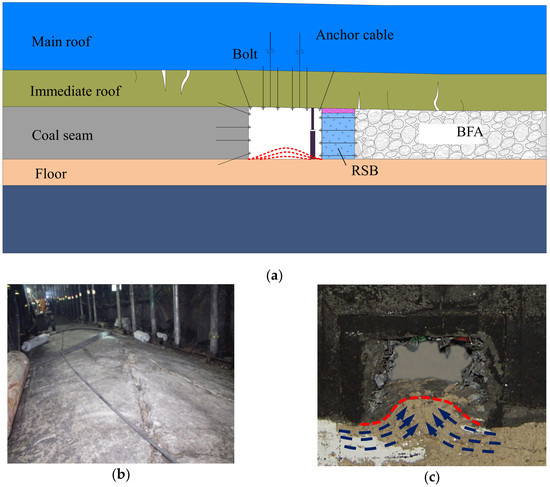Floor Heave Mechanism of Gob-Side Entry Retaining with Fully-Mechanized Backfilling Mining
Abstract
:1. Introduction
2. Engineering Property of Gob-Backfilled GER
2.1. Mining Geological Conditions
2.2. Source of Floor Stress in Gob-Backfilled GER
3. Establishment of Mechanical Model for Floor Heave of Gob-Backfilled GER
4. Floor Heave Mechanism of Gob-Backfilled GER
4.1. Analysis of Influencing Factors for Floor Heave of Gob-Backfilled GER
4.1.1. Influence of Geological Conditions on the Floor
4.1.2. Influence of Load of the Solid Coal Side on the Development Depth of the Plastic Zone in the Floor
4.1.3. Influence of Gob-Side Load on the Developmental Depth of the Plastic Zone in the Floor
4.2. Floor Heave Mechanism of Working Face in Gob-Backfilled GER of the Test Mine
5. Field Test and Monitoring
5.1. Control Principle of Floor Heave
- (1)
- With respect to improving the mechanical properties of floor strata: the deformation of the floor decreases with the increase of the elastic modulus of the floor rock, and the development depth of the plastic zone decreases with the increase of c and φ value. Based on the above results, the broken soft rock in the plastic zone of the floor can be performed with grouting reinforcement and repair to improve their elastic modulus and c, φ values, reducing the plastic zone of the floor and controlling the floor deformation (Figure 15a). In addition, the length, angle, and other parameters of floor grouting pipe can be rationally designed according to the developing depth and distribution characteristics of the plastic zone.
- (2)
- With respect to increasing the minimum principal stress of the roadway floor: the principal stress of the roadway floor is compressive stress, and squeezing action is exerted in the roadway. Therefore, the floor can be poured with a concrete-forming counter-arched slab to optimize the load-bearing structure of the floor and improve its flexural rigidity. Meanwhile, according to the calculation results of the distribution of the plastic zone in the floor under different conditions, anchor bolts are set from the counter-arched floor to the deep surrounding rock and fixed in the elastic zone of the floor; that is, the length of the bolts should be greater than the calculated value of the depth of the plastic zone in the floor (Figure 15b). Therefore, the concrete-poured floor can be integrated with the deep intact rock through the tension of the bolts, increasing the minimum principal stress of the floor, optimizing the stress environment of the floor and reducing the floor heave in the roadway.
- (3)
- With respect to reducing the maximum principal stress of the roadway floor: the horizontal stress of the floor on the roadway is the external factor causing floor heave in the roadway, and thus stress relief slots can be arranged on the floor to reduce the principal stress in the horizontal direction of the roadway (Figure 15c). The depth of the stress relief zone can refer to the calculated distribution range of the relief zone of the maximum horizontal stress. In addition, the stress relief slots should be arranged near the solid coal side. The reason is that the stress relief slots provide two free surfaces for the floor rock to release deformation in the horizontal direction. The horizontal displacement of the floor near the stress relief slot is the superposition of the deformation in the horizontal direction of each position. The maximum horizontal displacement of the roadway floor should occur near the stress relief slot under the action of horizontal stress. Therefore, when the distance between the stress relief slot and the RSB is small, the horizontal displacement of the lower part of the RSB increases, which is not conducive to the stability of the RSB.
- (4)
- With respect to optimizing the upper load of the floor: the horizontal pushing force of the backfill hydraulic support on the rear BFA is improved to increase the initial compaction of the granular gangue in the BFA and reduce the initial subsidence of the roof at the gob side, and thus, to decrease the given deformation of the roof at the solid coal side and reduce the stress concentration factor K of the solid coal side. In addition, the working resistance of the RSB at the gob side should be appropriately improved. Meanwhile, the horizontal pushing force of the hydraulic support is adjusted, and the support pressure of the BFA close to the roadway side is reduced to move the plastic zone of the floor to the gob side, and provide new channels for the release of deformation and stress of the floor in the gob, which is favorable for maintaining the stability of the floor in the roadway.
5.2. Design of the Floor Heave Control Scheme
- (1)
- The horizontal pushing force of three end backfill hydraulic supports at the working surface close to the side of the roadway is eliminated, which is favorable for the movement and deformation release of the plastic zone in the floor of the roadway.
- (2)
- Holes are drilled in the roadway floor 500 mm away from the two sides for grouting. Grouting holes are set outside of the roadway by 20° with a depth of 2.6 m and a grouting pressure of 2 MPa. Cement grout is used with cement label of P.O. 42.5 and a water-cement ratio of 1:0.8. Through the diffusion of the grout, the deep plastic zone in the floor is reinforced to carry the horizontal pressure of the floor of the roadway.
- (3)
- Stress relief slots are arranged on the floor 100 mm away from the solid coal side of the roadway. The stress relief slots are 300 mm wide and 700 mm deep. As the surface of roadway floor is a free surface and the maximum principal stress of the shallow floor is distributed in the horizontal direction, the bearing structure determines that the shallow surrounding rock of the floor does not have high carrying capacity. Therefore, stress relief slots are arranged in the shallow rock to provide space for the deformation release of the shallow floor in the horizontal direction, which can effectively reduce its maximum principal stress and ensure the completeness of the floor surface of the roadway.
- (4)
- A 300-mm thick hardening layer is formed on the floor surface by concrete pouring. The concrete strength of the hardening layer is C30. Steel plates are laid at the location of stress relief slot on the concrete surface.
5.3. Field Monitoring
6. Conclusions
- (1)
- The theoretical model established herein can be used to obtain the analytical expressions of the stress field and displacement field in the vertical and horizontal directions of the floor strata, and thus to obtain the distribution law of the principal stress field and plastic zone of the floor, providing an effective means for directly analyzing the floor heave mechanism of GER.
- (2)
- The parametric analysis results show that the maximum floor heave of the roadway increases with the increase of the coal seam depth, and decreases with the increase of the elastic modulus of the floor rock. The development depth of the plastic zone in the roadway floor decreases with the increase of the c and φ value of the floor rock and the support resistance of the RSB, and increases with the increase of the stress concentration factor of the solid coal side.
- (3)
- The distribution results of the stress field and the plastic zone of the floor in the gob-backfilled GER of the test mine show that the development depth of the plastic zone in the test mine is 2.68 m. The horizontal stress of the floor in the roadway is the external factor directly causing floor heave in the roadway. Other external factors affect the failure characteristics of roadway floor by changing the horizontal stress of the floor in the roadway.
- (4)
- Based on the theoretical analysis results, floor heave can be effectively controlled by improving the mechanical properties of floor strata, adjusting the principal stress of the floor and optimizing the upper load of the floor. The field test and monitoring results show that the comprehensive control scheme of adjusting backfilling pressure, deep grouting reinforcement, shallow opening stress relief slots, and surface pouring can effectively control the floor heave of the gob-backfilled GER. The roadway section meets the design and application requirements when the deformation stabilizes. The research results overcome the technical bottleneck of floor heave control in gob-backfilled GER, providing a reliable basis for the design of the floor heave control scheme.
Acknowledgments
Author Contributions
Conflicts of Interest
References
- Yang, H.; Cao, S.; Wang, S.; Fan, Y.; Wang, S.; Chen, X. Adaptation assessment of gob-side entry retaining based on geological factors. Eng. Geol. 2016, 209, 143–151. [Google Scholar] [CrossRef]
- Xue, J.H.; Han, C.L. Strata behavior and control countermeasures for the gob-side entry retaining in the condition of large mining height. J. Min. Saf. Eng. 2012, 29, 466–473. [Google Scholar]
- Dong, Z.; Xie, M.; Xian, M. Simulation on roof activities of gob-side entry retaining in fully-mechanized top-coal caving faces. J. China Univ. Min. Technol. 2001, 30, 261–264. [Google Scholar]
- Lu, Y.; Zuo, S.; Ge, Z.; Xiao, S.; Cheng, Y. Experimental study of crack initiation and extension induced by hydraulic fracturing in a tree-type borehole array. Energies 2016, 9, 514. [Google Scholar] [CrossRef]
- Lu, Y.; Cheng, Y.; Ge, Z.; Cheng, L.; Zuo, S.; Zhong, J. Determination of fracture initiation locations during cross-measure drilling for hydraulic fracturing of coal seams. Energies 2016, 9, 358. [Google Scholar] [CrossRef]
- Chen, Y.; Bai, J.B.; Wang, X.Y.; Ma, S.Q.; Xu, Y.; Bi, T.F.; Yang, H.Q. Support technology research and application inside roadway of gob side entry retaining. J. China Coal Soc. 2012, 37, 903–910. [Google Scholar]
- Jiang, B.; Wang, L.; Lu, Y.; Gu, S.; Sun, X. Failure mechanism analysis and support design for deep composite soft rock roadway: A case study of the yangcheng coal mine in china. Shock Vib. 2015, 2015. [Google Scholar] [CrossRef]
- Feng, X.; Zhang, N.; Gong, L.; Xue, F.; Zheng, X. Application of a backfilling method in coal mining to realise an ecologically sensitive “black gold” industry. Energies 2015, 8, 3628–3639. [Google Scholar] [CrossRef]
- Ma, Z.; Gu, R.; Huang, Z.; Peng, G.; Zhang, L.; Ma, D. Experimental study on creep behavior of saturated disaggregated sandstone. Int. J. Rock Mech. Min. Sci. 2014, 66, 76–83. [Google Scholar] [CrossRef]
- Miao, X.X.; Zhang, J.X. Analysis of strata behavior in the process of coal mining by gangue backfilling. J. Min. Saf. Eng. 2007, 24, 379–382. [Google Scholar]
- Sheshpari, M. A review of underground mine backfilling methods with emphasis on cemented paste backfill. Electron. J. Geotech. Eng. 2015, 20, 5183–5208. [Google Scholar]
- Jehring, M.M.; Bareither, C.A. Tailings composition effects on shear strength behavior of co-mixed mine waste rock and tailings. Acta Geotech. 2016, 11, 1–20. [Google Scholar] [CrossRef]
- Huang, Y.L.; Li, J.M.; Song, T.Q.; Kong, G.Q.; Li, M. Analysis on filling ratio and shield supporting pressure for overburden movement control in coal mining with compacted backfilling. Energies 2017, 10, 31. [Google Scholar] [CrossRef]
- He, M.C.; Zhang, G.F.; Wang, G.L.; Xu, Y.L.; Wu, C.Z.; Tang, Q.D. Research on mechanism and application to floor heave control of deep gateway. Chin. J. Rock Mech. Eng. 2009, 28, 2593–2598. [Google Scholar]
- Lin, D.; Wei, X.; Chunzhao, X.U.; Tang, B. Research on the type and deformation mechanism of floor heave of swelling soft rock roadway along goaf in deep mine. Min. Res. Dev. 2013, 33, 23–26. [Google Scholar]
- Sun, X.M.; Chen, F.; He, M.C.; Gong, W.L.; Xu, H.C.; Lu, H. Physical modeling of floor heave for the deep-buried roadway excavated in ten degree inclined strata using infrared thermal imaging technology. Tunn. Undergr. Space Technol. 2017, 63, 228–243. [Google Scholar] [CrossRef]
- Tang, S.B.; Tang, C.A. Numerical studies on tunnel floor heave in swelling ground under humid conditions. Int. J. Rock Mech. Min. Sci. 2012, 55, 139–150. [Google Scholar] [CrossRef]
- Li, X.; Weng, L. Numerical investigation on fracturing behaviors of deep-buried opening under dynamic disturbance. Tunn. Undergr. Space Technol. 2016, 54, 61–72. [Google Scholar] [CrossRef]
- Zhang, N.; Yuan, L.; Han, C.; Xue, J.; Kan, J. Stability and deformation of surrounding rock in pillarless gob-side entry retaining. Saf. Sci. 2012, 50, 593–599. [Google Scholar] [CrossRef]
- Gong, P.; Ma, Z.; Zhang, R.R.; Ni, X.; Liu, F.; Huang, Z. Surrounding rock deformation mechanism and control technology for gob-side entry retaining with fully mechanized gangue backfilling mining: A case study. Shock Vib. 2017, 2017, 1–15. [Google Scholar] [CrossRef]
- Zhang, Z.; Bai, J.; Chen, Y.; Yan, S. An innovative approach for gob-side entry retaining in highly gassy fully-mechanized longwall top-coal caving. Int. J. Rock Mech. Min. Sci. 2015, 80, 1–11. [Google Scholar] [CrossRef]
- Han, C.L.; Zhang, N.; Li, B.Y.; Si, G.Y.; Zheng, X.G. Pressure relief and structure stability mechanism of hard roof for gob-side entry retaining. J. Cent. South Univ. 2015, 22, 4445–4455. [Google Scholar] [CrossRef]
- Song, Z.Q.; Cui, Z.D.; Xia, H.C.; Tang, J.Q.; Wen, Z.J. The fundemental theoretial and engineering research on the green safe no coal pillar mining model by mainly using coal gangue backfill. J. China Coal Soc. 2010, 35, 705–710. [Google Scholar]
- Yong, C.; Bai, J.; Shuai, Y.; Ying, X.; Wang, X.; Ma, S. Control mechanism and technique of floor heave with reinforcing solid coal side and floor corner in gob-side coal entry retaining. Int. J. Min. Sci. Technol. 2012, 22, 832–836. [Google Scholar]
- Han, C.L.; Zhang, N.; Qian, D.Y.; Xue, B. Optimization analysis of span-depth ratio for roof safety control in gob-side entry retaining under large mining height. J. Min. Saf. Eng. 2013, 30, 348–354. [Google Scholar]
- Zhang, N.; Han, C.L.; Han, J.G.; Zheng, X.G. Theory and practice of surrounding rock control for pillarless gob-side entry retaining. J. China Coal Soc. 2014, 39, 1635–1641. [Google Scholar]
- Jiang, B.; Wang, Q.; Li, S.C.; Ren, Y.X.; Zhang, R.X.; Wang, H.T.; Zhang, B.; Pan, R.; Shao, X. The research of design method for anchor cables applied to cavern roof in water-rich strata based on upper-bound theory. Tunn. Undergr. Space Technol. 2016, 53, 120–127. [Google Scholar] [CrossRef]
- Dai, Y.S.; Tan, Y.H.; Wu, J.H.; Wang, Y.; Lu, C.H. Properties of bolt-grouting mortar modified with mineral bauxite by chemical activation. J. Mater. Civ. Eng. 2016, 28, 4016057. [Google Scholar] [CrossRef]
- Cao, P.; Haoyue, L.I.; Zhong, Y.; Wang, F. Mechanism and control of floor heave of deep buried roadway with high lateral pressure coefficient. J. Cent. South Univ. 2017, 48, 457–464. [Google Scholar]
- Sun, J. Numerical simulation of grooving method for floor heave control in soft rock roadway. Int. J. Min. Sci. Technol. 2011, 21, 49–56. [Google Scholar]
- Ma, Z.; Huang, Z.; Fan, J.; Zhao, G.; Sun, K.; Liu, F. Experimental research on compacting characteristics of open-air slag mixture. China Coal 2012, 38, 36–38. [Google Scholar]
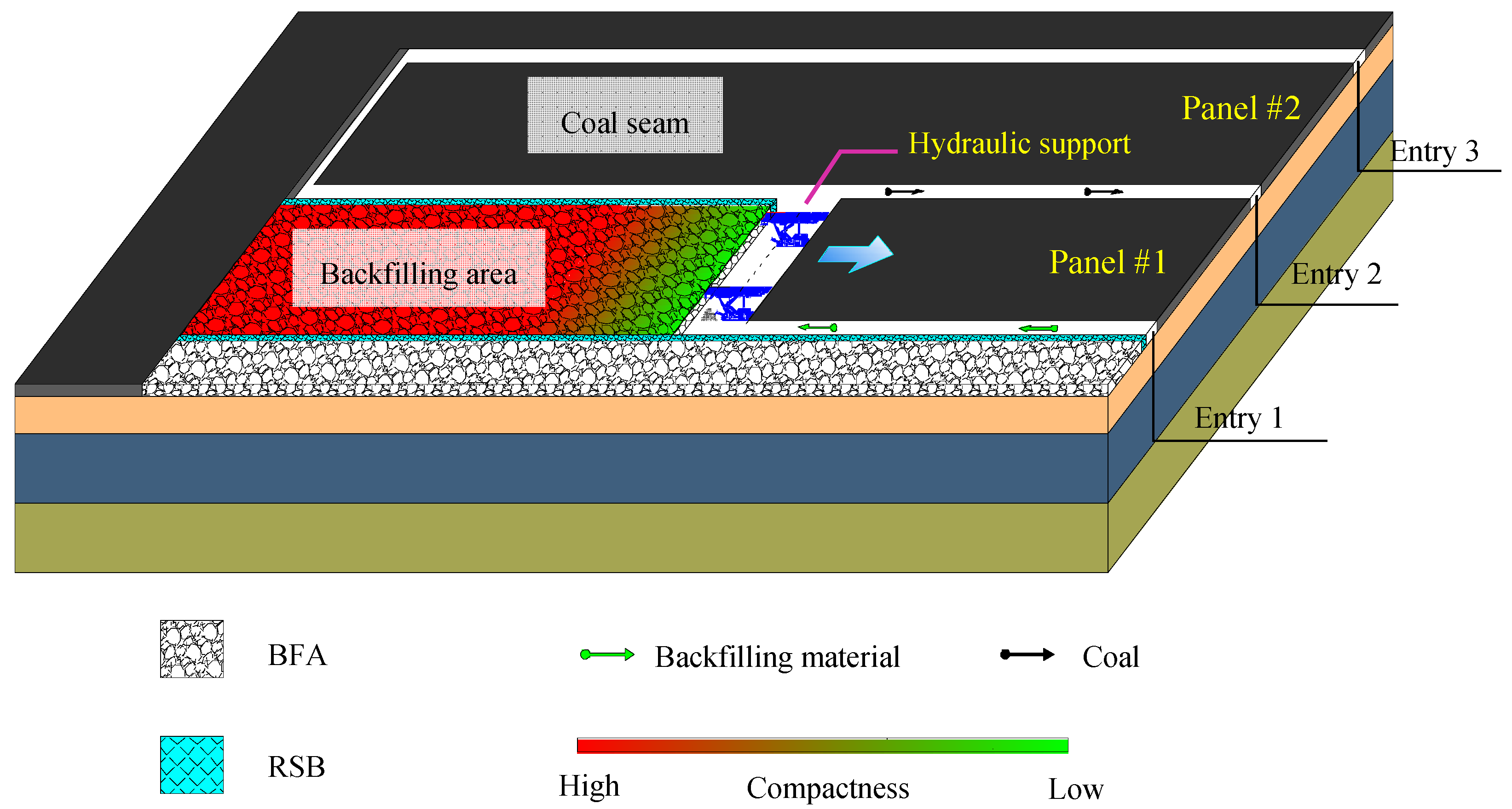

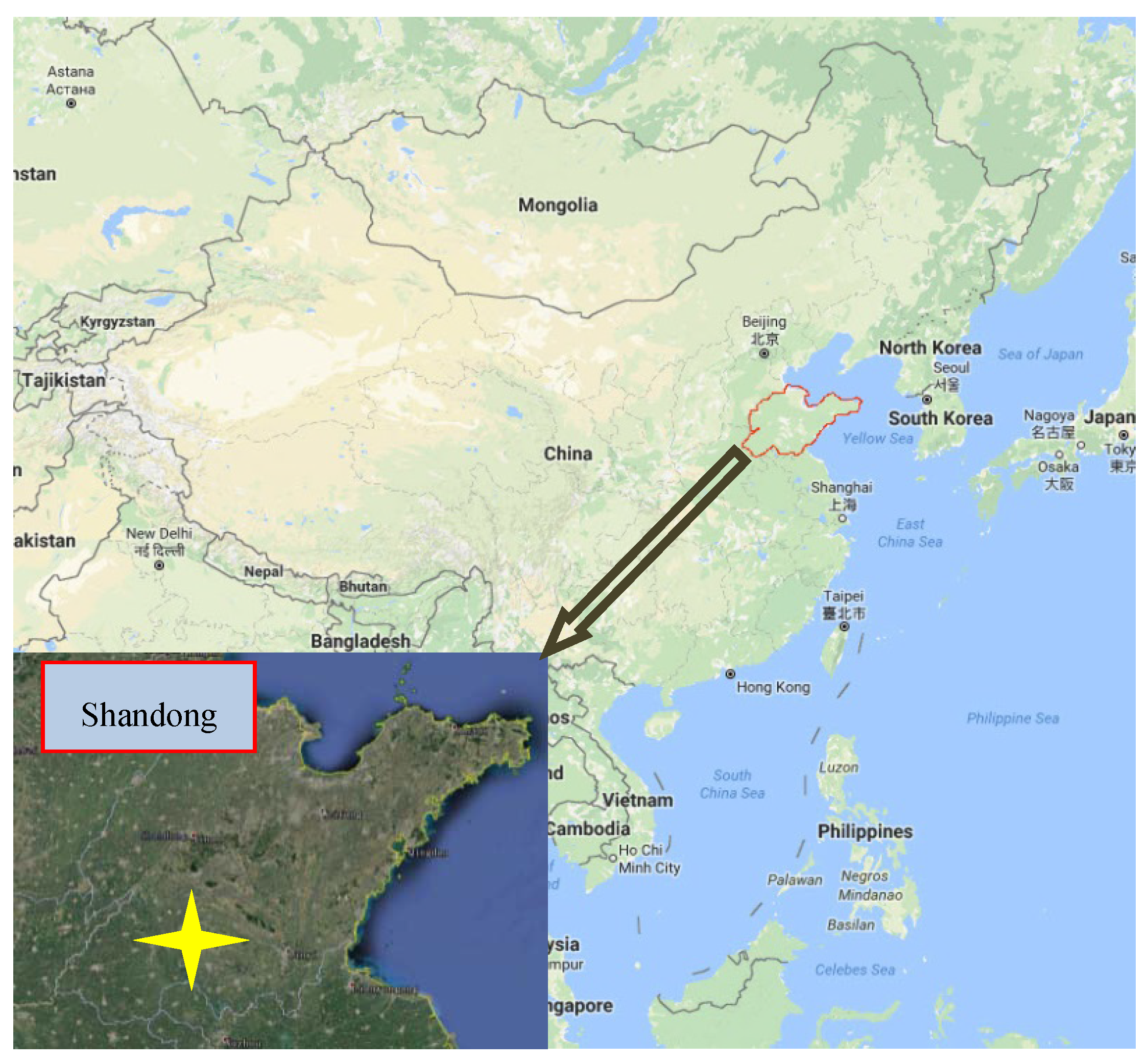
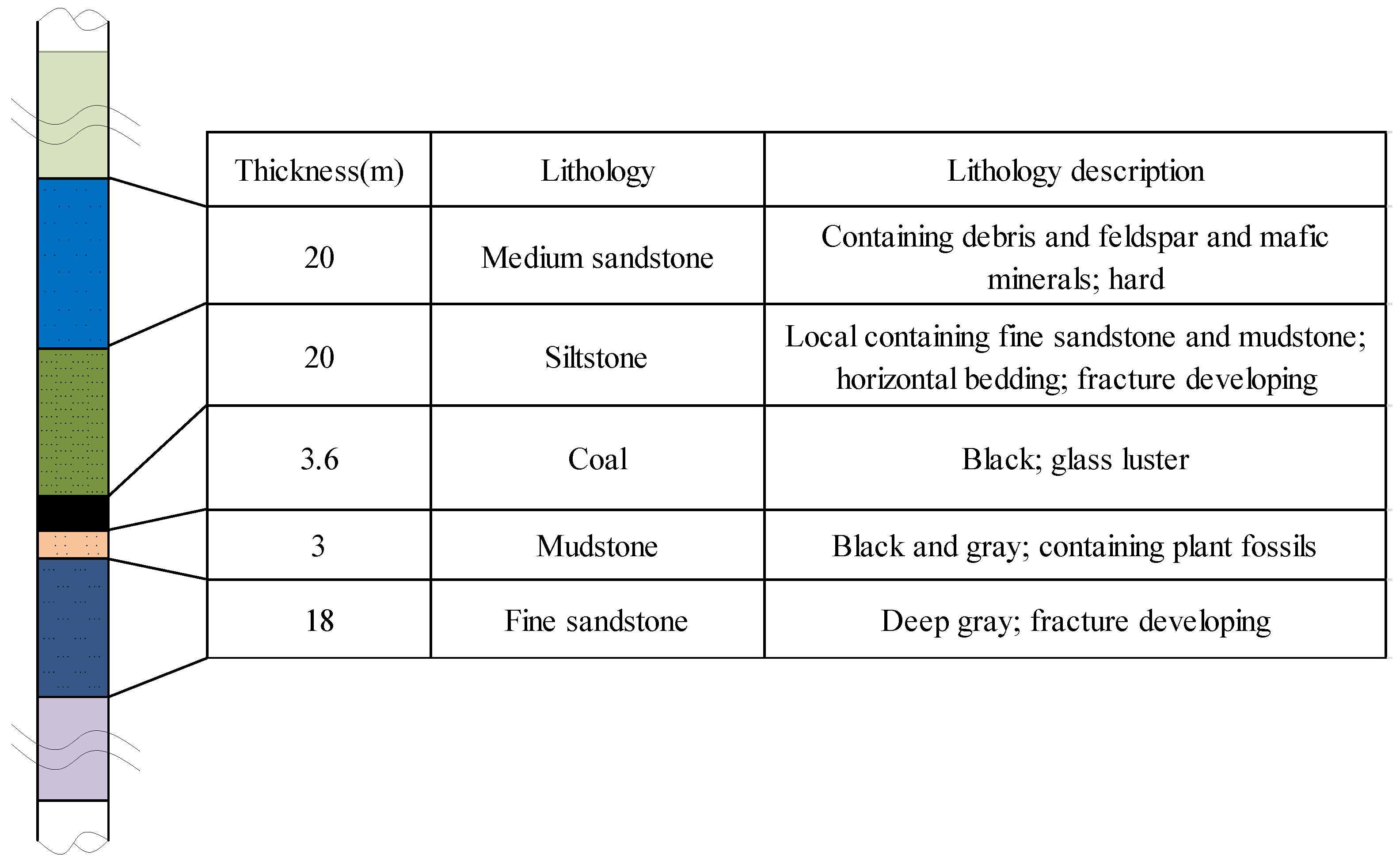

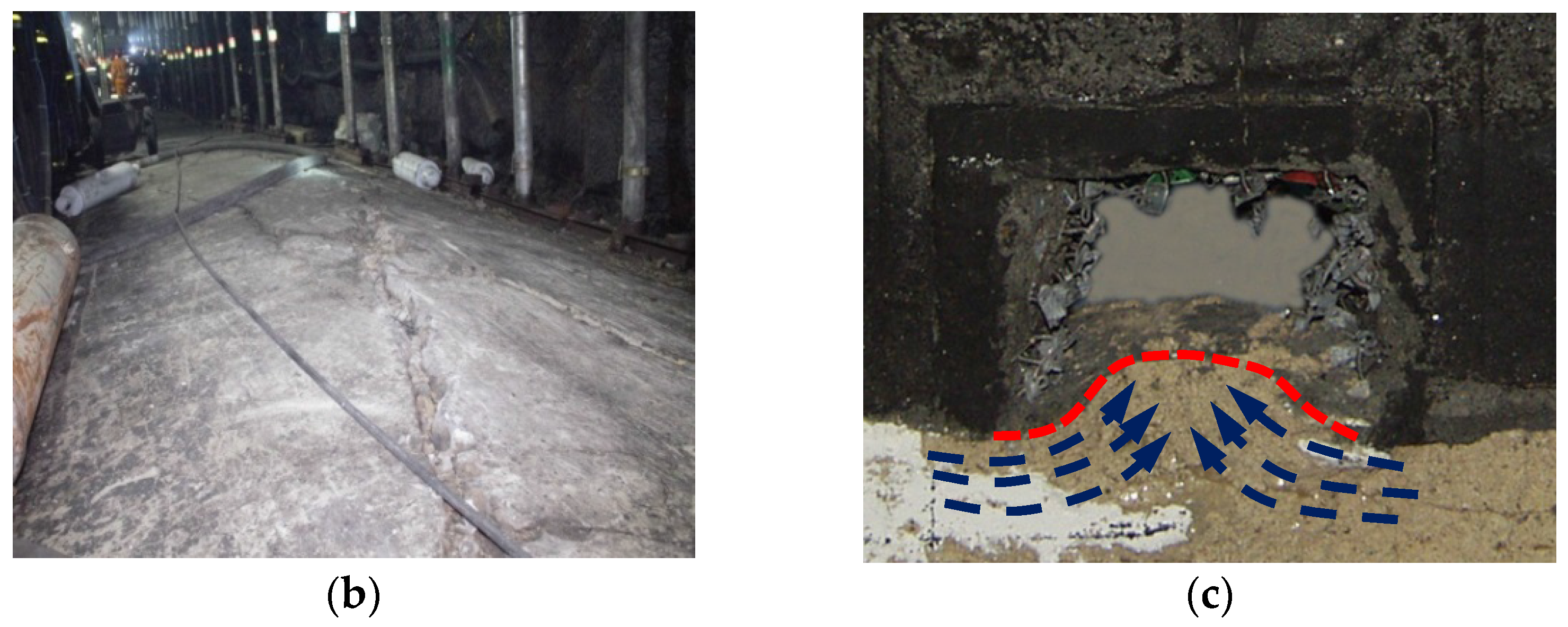
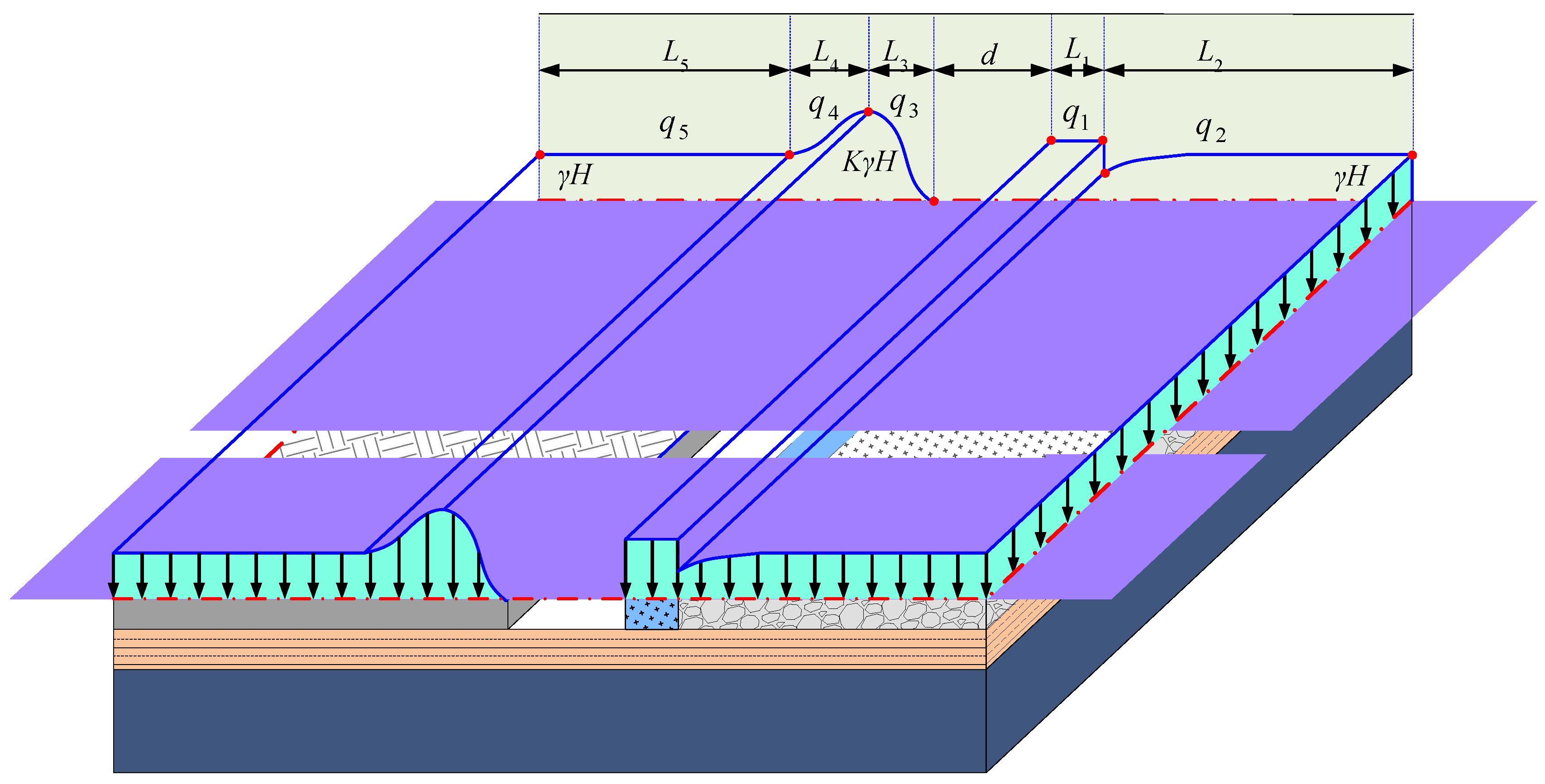

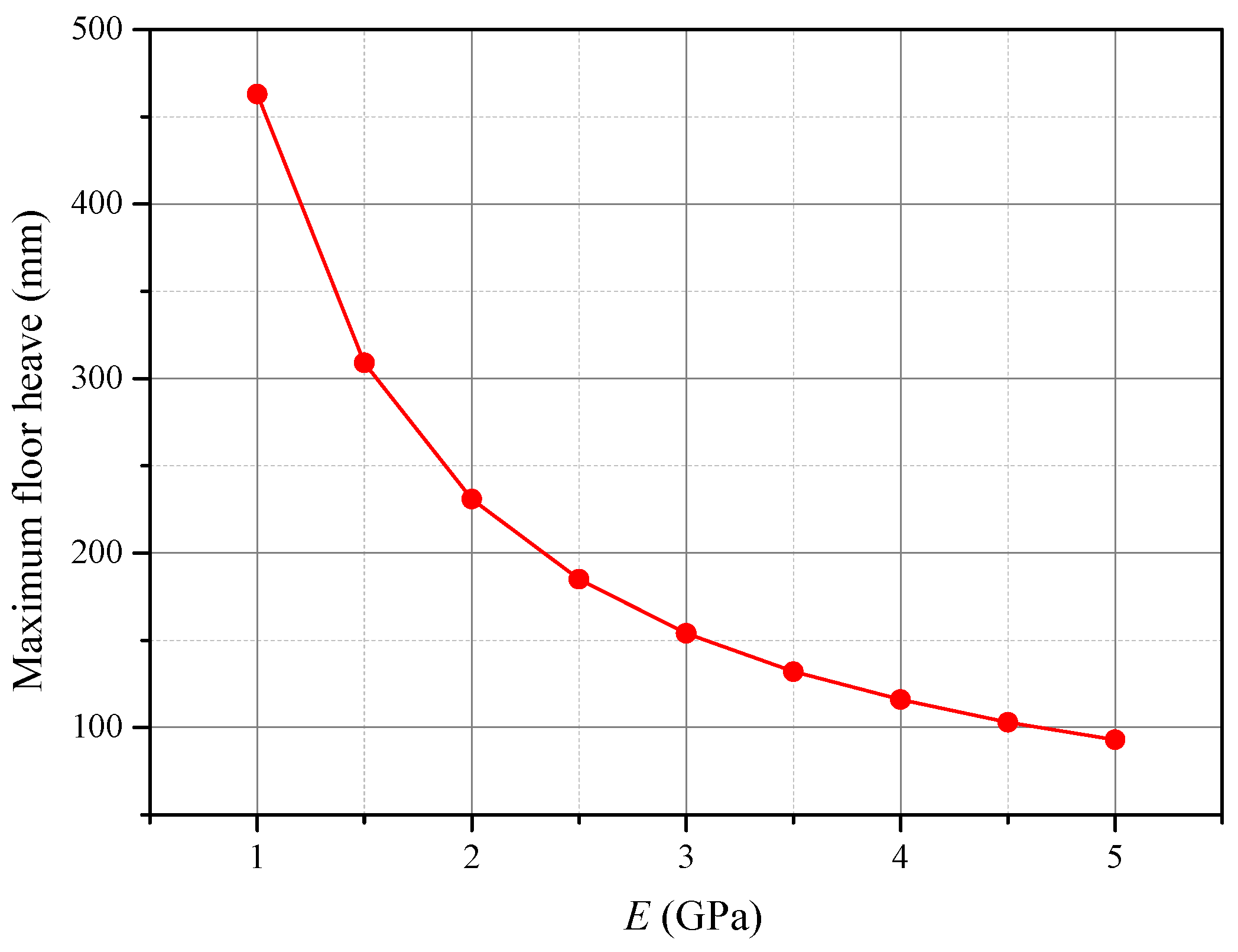

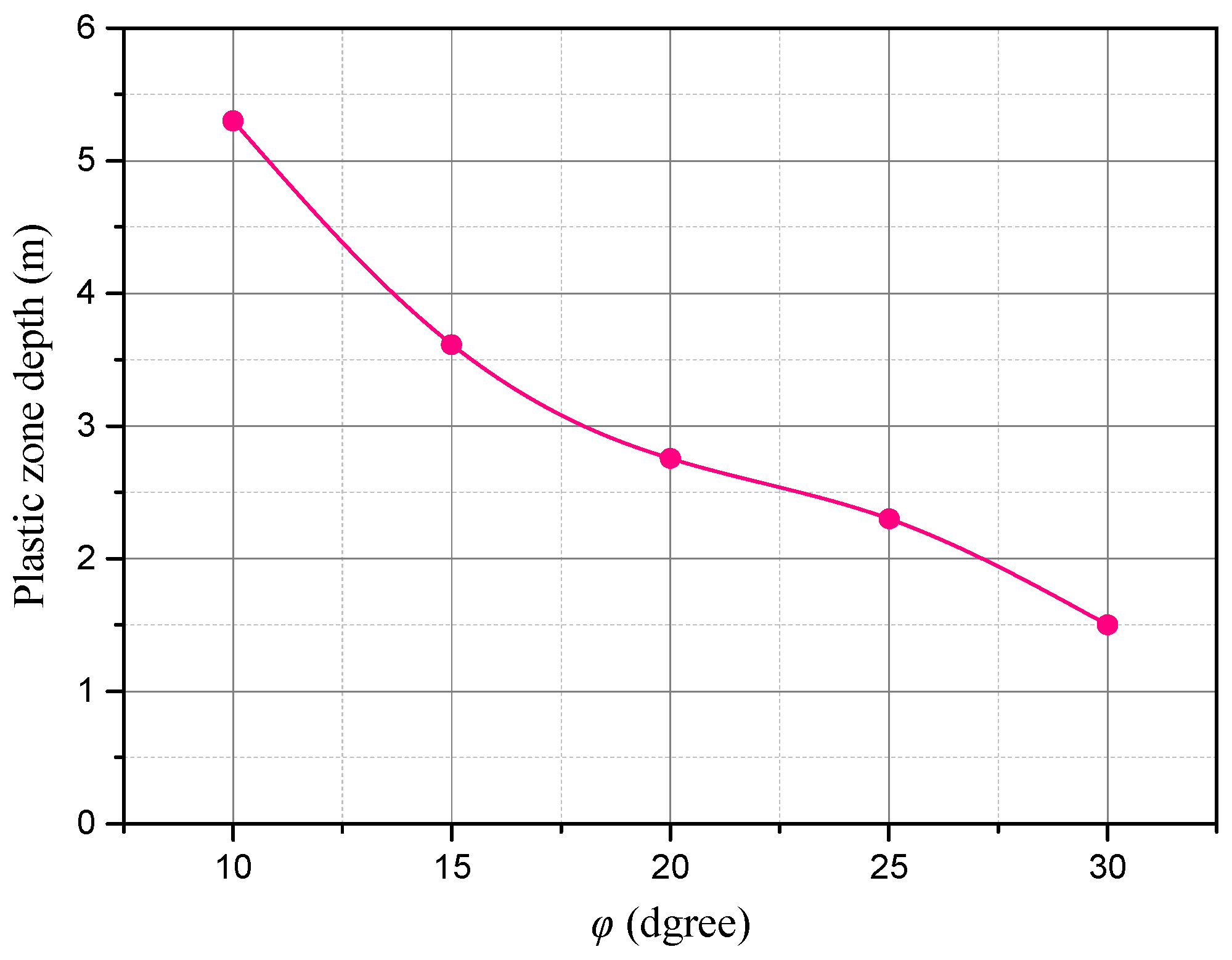
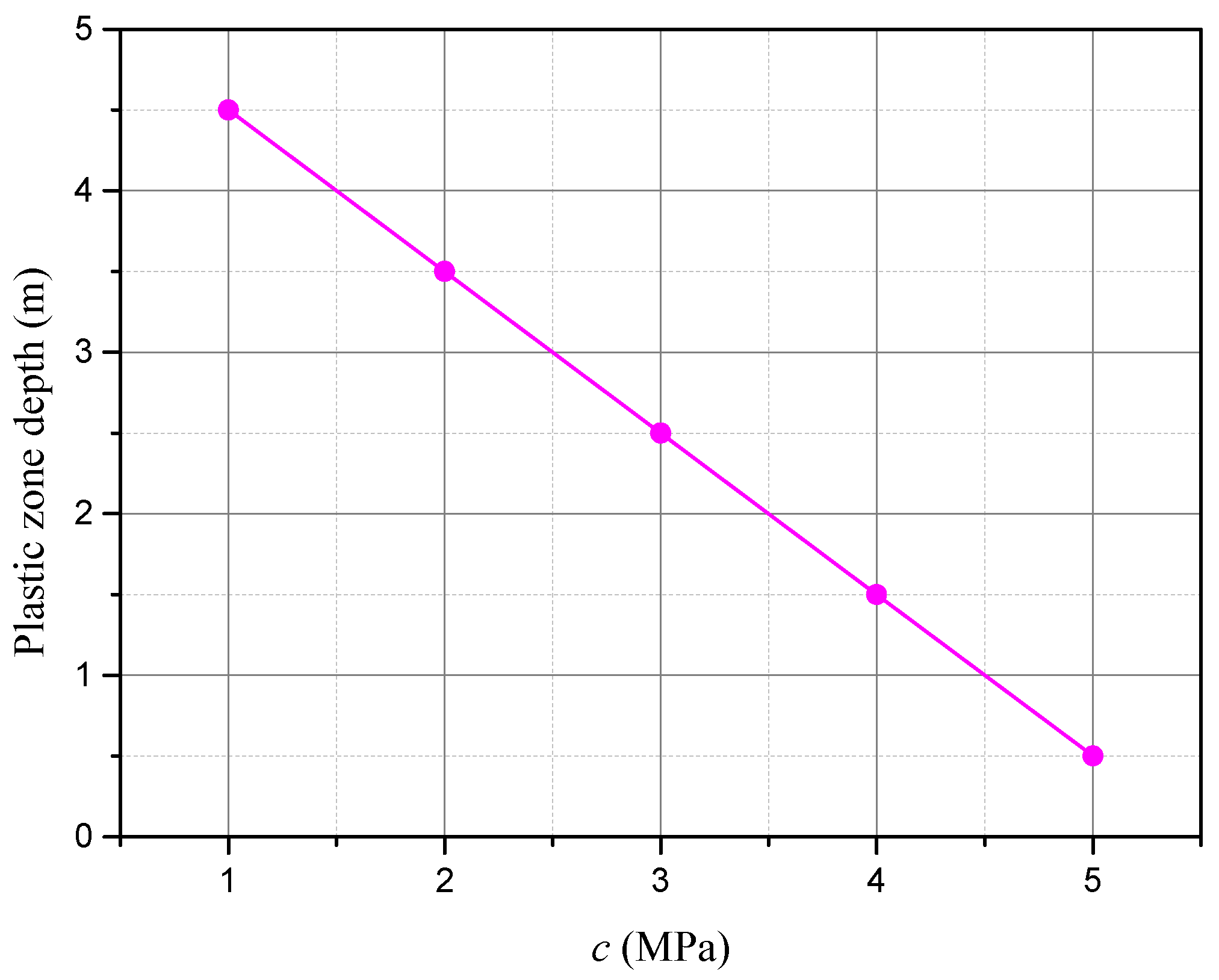
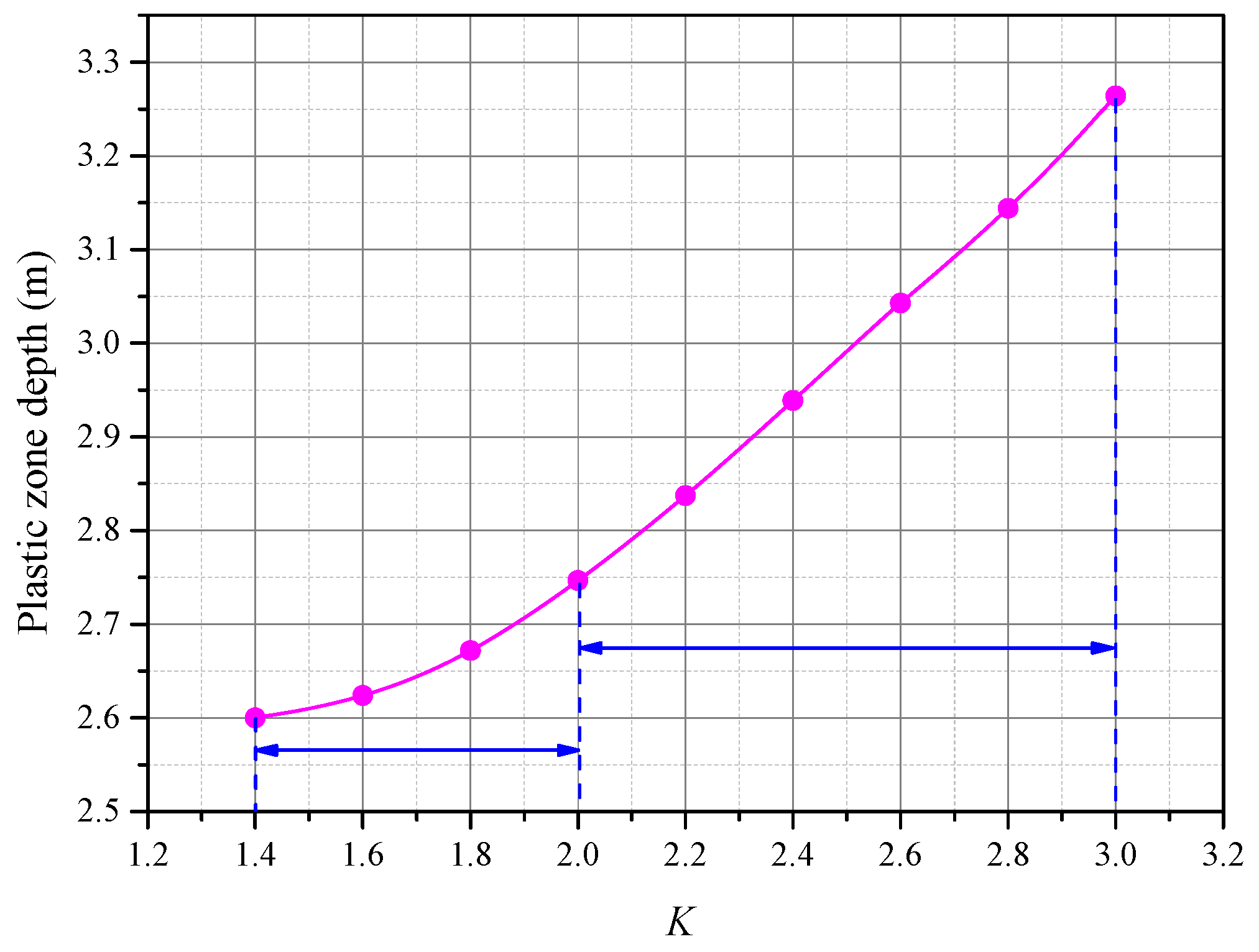
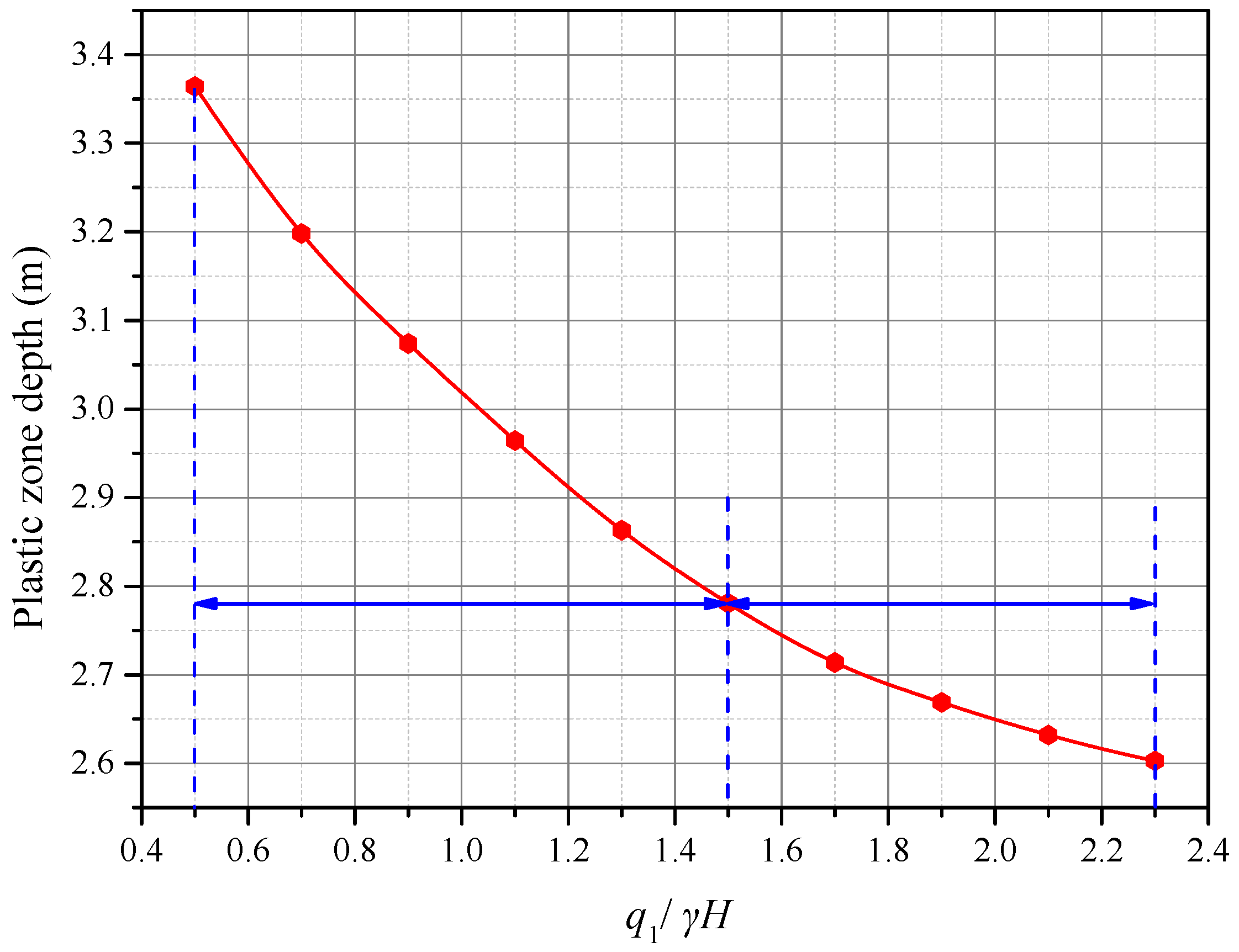
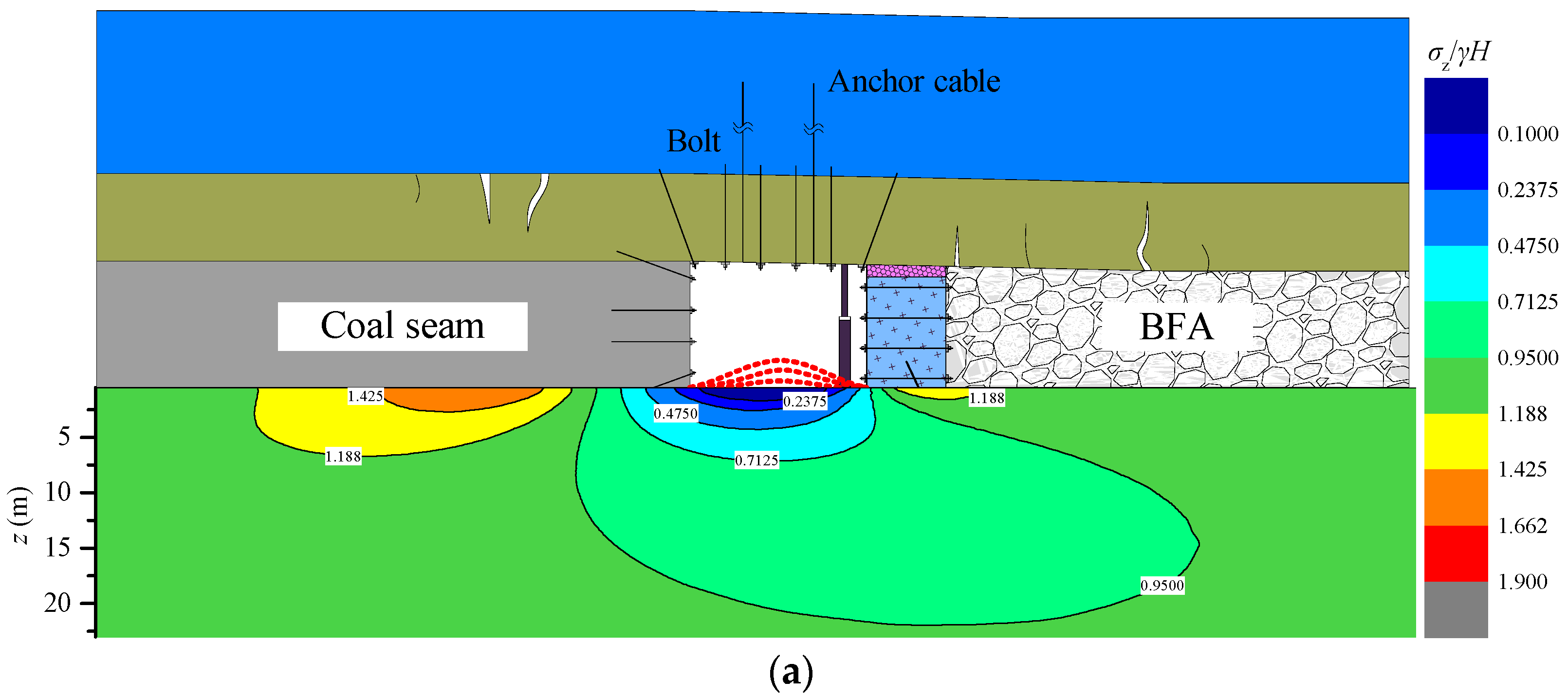


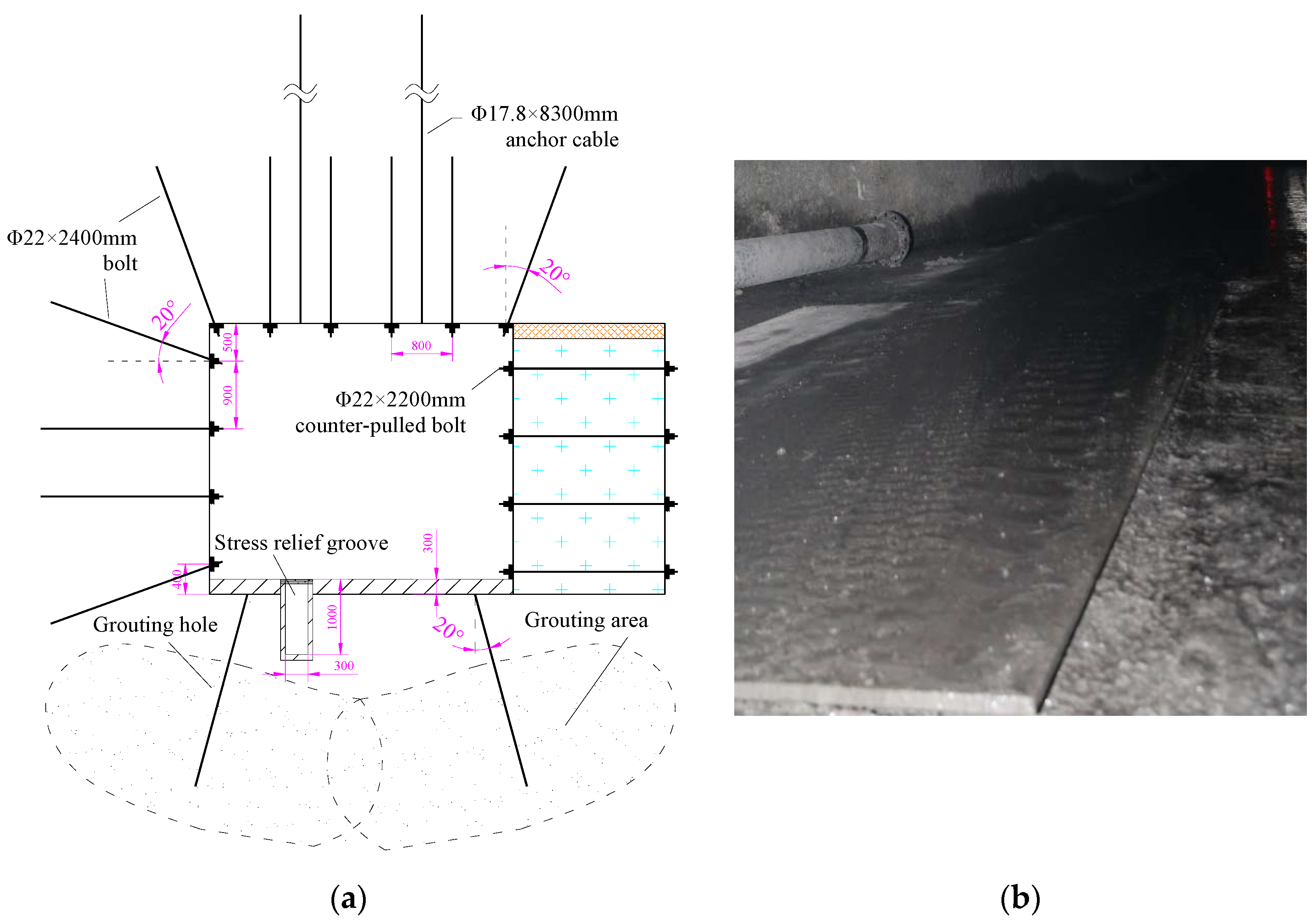
| L1/m | L3/m | L4/m | d/m | K | L1/m | |
|---|---|---|---|---|---|---|
| 2 | 4 | 8 | 4 | 1.53 | 1.3γH | 2 |
© 2017 by the authors. Licensee MDPI, Basel, Switzerland. This article is an open access article distributed under the terms and conditions of the Creative Commons Attribution (CC BY) license (http://creativecommons.org/licenses/by/4.0/).
Share and Cite
Gong, P.; Ma, Z.; Ni, X.; Zhang, R.R. Floor Heave Mechanism of Gob-Side Entry Retaining with Fully-Mechanized Backfilling Mining. Energies 2017, 10, 2085. https://doi.org/10.3390/en10122085
Gong P, Ma Z, Ni X, Zhang RR. Floor Heave Mechanism of Gob-Side Entry Retaining with Fully-Mechanized Backfilling Mining. Energies. 2017; 10(12):2085. https://doi.org/10.3390/en10122085
Chicago/Turabian StyleGong, Peng, Zhanguo Ma, Xiaoyan Ni, and Ray Ruichong Zhang. 2017. "Floor Heave Mechanism of Gob-Side Entry Retaining with Fully-Mechanized Backfilling Mining" Energies 10, no. 12: 2085. https://doi.org/10.3390/en10122085



